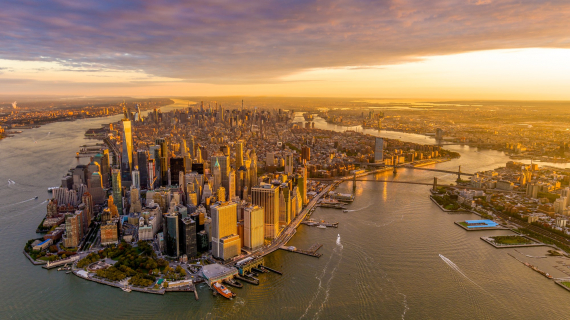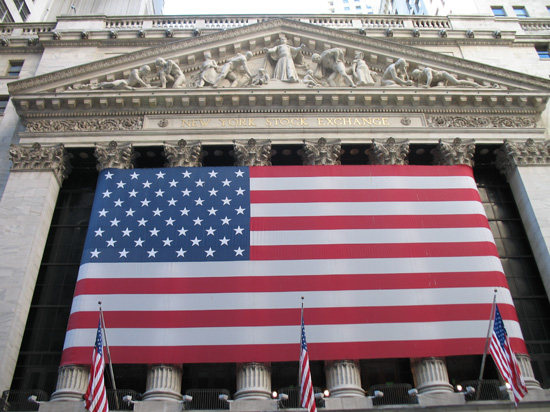
Mayor de Blasio, New York City Economic Development Corporation (NYCEDC) and the Mayor's Office of Climate Resiliency (MOCR) today released the Financial District and Seaport Climate Resilience Master Plan, a blueprint for comprehensive flood defense infrastructure to protect Lower Manhattan from the urgent threat of climate change. The plan, projected to cost $5 to $7 billion, reimagines the shoreline of Lower Manhattan and creates a resilient waterfront to withstand severe coastal storms and rising sea levels. Nearly one million people work in, live in, and commute through the low-lying Financial District and South Street Seaport neighborhoods. Illustrative images of the design proposal can be found here (credit: NYCEDC).
Protecting Lower Manhattan is imperative to New York City’s overall coastal resilience strategy. It is one of the nation’s largest central business districts, with half of workers coming from the outer boroughs; a critical hub of the subways and PATH transit systems and the regional highway network; and an iconic destination for millions of visitors from around the US and the world. Using the New York City Panel on Climate Change 90th percentile projections, by the 2050s rising tides are projected to flood the Financial District and Seaport monthly, then daily by the 2080s. Some level of frequent tidal flooding is likely to be seen as early as the 2040s.
“This Plan for a protected and resilient waterfront in Lower Manhattan will help us fully confront the urgent and accelerating threat of climate change,” said Mayor Bill de Blasio. “A recovery for all of us must ensure families, businesses, and communities in Lower Manhattan are able to withstand extreme weather and rising sea levels, which this vision guarantees.”
To protect the area, which was hard-hit by Hurricane Sandy in 2012, the master plan features a multilevel waterfront that extends the shoreline of the East River by up to 200 feet from its existing location. The upper level will be elevated by about 15 to 18 feet to protect against severe storms like Sandy, while doubling as public open spaces with sweeping views of the city and harbor. The lower level will be a continuous waterfront esplanade, raised three to five feet to protect against sea level rise while connecting New Yorkers to the water's edge. From now through 2100, if no action is taken, repetitive flooding is projected to cause up to $20 billion in estimated losses to the region. The master plan will safeguard Lower Manhattan in a time of rising sea levels and more frequent and intense coastal storms.
The master plan encompasses almost one mile of waterfront from The Battery to the Brooklyn Bridge. Notable features of the proposed plan include:
- Floodwalls buried in the landscape that create a line of ridges along this waterfront, permanently protecting Lower Manhattan from coastal storms and creating new open spaces with expansive views of the harbor
- Resilient stormwater infrastructure, including a new pump station along with green infrastructure
- Resilient ferry terminals for Staten Island, Governors Island, and NYC Ferries, among other operators
- Universally accessible entrances and pathways, designed to ensure people of all ages and abilities can get to and move around the waterfront
- New public open spaces with playgrounds, plazas, lawns, seating, and cafes
- Coves that promote habitat restoration and provide opportunities to learn about the ecology of the East River
- Resilient piers for docking historic ships, bolstering the historic character of South Street Seaport
The City has worked closely with the community to shape this plan. Through numerous public meetings and workshops, an online engagement portal, youth outreach with local schools, and other creative forms of engagement, the City incorporated feedback at every step along the way. To maximize outside input, the City also formed the Climate Coalition for Lower Manhattan, a group of local and citywide stakeholders chaired by Elizabeth Yee, Executive Vice President and Chief of Staff at The Rockefeller Foundation, and Tammy Meltzer, Chairperson of Manhattan Community Board 1.
“NYCEDC and MOCR have envisioned a 21st-Century resilient waterfront that stands to be a model for other major cities,” said NYCEDC President and CEO Rachel Loeb. “We’ve done years of work, and we have the innovation. There’s no doubt climate change is here. Sea levels are rising, and stronger, more devastating storms will only continue, which is why we must protect our coastline and safeguard our vulnerable historic Seaport area and Financial District. If we do not take action now residents, businesses, and critical infrastructure are put in jeopardy. We must rely on strong partnerships at all levels of government to help implement this plan.”
“The FiDi & Seaport Climate Resilience Master Plan provides the vision and blueprint for a resilient waterfront that can withstand the impacts of future coastal storms and sea level rise,” said Jainey Bavishi, Director of the Mayor’s Office of Climate Resiliency. ”The Master Plan is a product of years of collaboration between MOCR, NYCEDC, numerous City agencies, elected officials, technical experts and most importantly, community members. We must get to the work of implementation without delay.”
"New York City’s future depends on us planning for the effects of coastal storms and sea level rise in vulnerable places,” said NYC Parks Commissioner Gabrielle Fialkoff. “This new master plan outlines a vision for transforming the shoreline in the Financial District and Seaport that prioritizes the need for public access and climate planning along Lower Manhattan's waterfront.”
“There is no threat more existential to the future of New York City, or the world, than that posed by the climate crisis. I have long advocated for desperately needed resiliency measures be implemented after Superstorm Sandy, and today’s release of the FiDi & Seaport Climate Resilience Master Plan is another important step in protecting these neighborhoods in Lower Manhattan from future storms,” said Congressman Jerry Nadler. “As we enter the next design and engineering phases of this project, I look forward to working with our federal, city, state partners to make our waterfront resilient and continuing to engage in robust dialogue with community members to make sure their needs are being met.”
“While we have a long way to go before there is a consensus regarding plans to protect the historic Seaport District from storm surge and other threats that come with climate change, I am pleased that the Economic Development Corporation and the Mayor's Office of Climate Resiliency have been working closely with elected officials, Community Board 1, local leaders, residents, and businesses to begin to articulate a vision as to how we might create resiliency in this especially challenging stretch of our Lower Manhattan waterfront,” said Senator Brian Kavanagh, who represents the Seaport District and Lower Manhattan. “I look forward to continuing to work with all stakeholders, including the incoming administration of Mayor-elect Eric Adams, toward a comprehensive approach that will safeguard our communities.”
“Protecting lower Manhattan from climate change is vital to the lives of the residents here and the economic welfare of New York,” said Assemblymember Yuh-Line Niou. “As the economic engine in New York and a major transportation hub in the city, it is critical that we invest now in climate resiliency efforts to combat climate change. Our communities are the backbone of what makes New York special, but we must plan and fund preparation for a more extreme climate. In addition, our community’s needs and addressing the potential environmental impacts from the plan must come first. There are many opportunities in this project to dedicate space for invaluable open and public community needs, and we must explore every option while committing to community engagement at every step.”
“Protecting Lower Manhattan is very vital to the city’s resiliency strategy along with protecting our business and residents,” said New York City Council Member Margaret Chin.” I want to commend the Mayor’s office of Climate Resiliency and the New York City Economic Development Corporation for addressing the major issues of climate change by providing clear and concrete plans by rebuilding our waterfront infrastructure to protect future large-scale flooding. In addition, the FiDi Seaport master plan will include increasing open space and access to the waterfront for Lower Manhattan. This gives our residents and visitors a new recreational amenity while protecting our shoreline. We must continue to do everything we can with investments in climate resiliency infrastructure that will carry on for the next generation of New Yorkers.”
“We must act boldly and quickly to protect our city from the effects of climate change," said Manhattan Borough President Gale A. Brewer. “Lower Manhattan is home to hundreds of thousands of New Yorkers and a critical economic engine, and the Seaport District is a historic and cultural treasure. This master plan lays a foundation for keeping Lower Manhattan safe from storm surge and sea level rise. I look forward to working with my colleagues in government and members of the community to continue to refine this plan and to ensure a safer climate future for New Yorkers.”
“The Financial District and Seaport Climate Resilience Master Plan sets forth a path to shoreline protection that could serve as a model for citywide protection,” said Julie Tighe, President of the New York League of Conservation Voters. “A comprehensive resiliency plan is vital to help keep our economy intact and protect our communities during more frequently occurring storms and sea level rise. There are numerous environmental and recreational benefits we will see from using green spaces as resiliency measures, and we look forward to seeing this plan implemented."
"Nearly 10 years after Hurricane Sandy took lives and flooded so many treasured parts of New York City, humanity and New Yorkers are still facing the existential threat of climate change as we saw this summer," said Elizabeth Yee, Executive Vice President, Program Strategy and Chief of Staff at The Rockefeller Foundation. "The Financial District and Seaport Climate Resilience Master Plan is not just a ground-breaking plan designed in partnership with the community to save lives and livelihoods, it's also a way for New York to show the rest of the country and the world how to use climate science and technological advances to help people live and thrive in our changing climate."
“Manhattan Community Board 1 thanks partners of the Fidi/Seaport Climate Resilience Master Plan for all of the hard work and efforts thus far in creating conceptual plans for the long-term protection of lower Manhattan's East Side,” said Tammy Meltzer, Chair of Manhattan’s Community Board 1. “We continue to stand firm in the prioritization of parkland filled with active and passive recreation opportunities, green infrastructure, community uses and understanding how this project will seamlessly connect with the other resiliency projects in order to ensure a comprehensive protection strategy. As we move into the next phase of planning, we reiterate the importance of community-based planning which will best steward public funds for maximum public benefit.”
"The major infrastructure envisioned in the Seaport-Fidi Master Plan underscores how this plan is not only about surviving the next storm, but about New York City emerging even stronger than before and planning for generations ahead," said Cortney Koenig Worrall, CEO and President, Waterfront Alliance. "The project serves as an example of the changes the City must undertake in the years ahead. We commend the City for taking on the gargantuan task of re-thinking the shoreline through innovative climate design while ensuring public amenities and quality public access."
“Insulating the Financial District and Seaport from extreme weather events and rising sea levels is necessary and smart. We support this initiative and hope that there will be effective public-private partnerships put in place to implement these thoughtful plans,” said Kathryn Wylde, President and CEO of the Partnership for New York City.
"Superstorm Sandy as well as last summer's severe weather and flooding are a powerful reminder that climate change isn't a future threat---it's already here and directly impacting lives and businesses," said Jessica Lappin, President of the Alliance for Downtown New York. "The FiDi-Seaport Climate Master Plan being released today is a thoughtful blueprint crafted with extensive feedback from a diverse range of stakeholders. It is a plan that can provide real long-term protection for one of our region's most important centers of economic opportunity and job growth. The time for action is now."
“Every day brings new information about the growing threat posed by climate change and rising sea levels,” said Catherine McVay Hughes, a board member of the Financial District Neighborhood Association. “The FiDi-Seaport district is on the front line facing these threats. NYC EDC developed this FiDi and Seaport resiliency plan with extensive and broad-based community engagement, building on prior resiliency planning and the NY Rising Community Reconstruction (NYRCR) Program after Hurricane Sandy. Funding and implementation cannot happen soon enough to minimize climate risk to major infrastructure, housing and business.”
“I am happy to know that this project is finally going to happen and protect residents of Smith Houses,” said Aixa Torres, President of the Resident Association for New York City Housing Authority’s Alfred E. Smith Houses. “But more importantly will help to serve as a healing venue for people who have respiratory health issues. Salt air is an agent of healing.”
“We believe this very promising project has been improved by addressing several important local needs rather than speculative high-rises for the expanded shoreline, including additional docking space for historic boats and other vessels, creation of active recreation space for youth of all ages, and ensuring that the historic fabric of this unique area is preserved,” said Michael Kramer, spokesperson for the Seaport Coalition.
“Regional Plan Association commends the New York City Economic Development Corporation and Mayor's Office of Climate Resiliency for their efforts on the FiDi and Seaport Climate Resilience Plan,” said Rob Freudenberg, Vice President for Energy & Environment, Regional Plan Association (RPA). “RPA’s Fourth Regional Plan, published in 2017, calls for these types of large-scale resilience approaches in neighborhoods like Lower Manhattan that are dense with residents and resources. The comprehensive approach to storm surge and sea level rise flooding outlined in this plan will protect the neighborhood for generations to come and serve as an example other neighborhoods can follow in New York City and beyond. We look forward to the forthcoming citywide approach to adaptation that will ensure all communities – especially the most vulnerable - can live with reduced risk equitably into the future.”
"New York City has already felt the impacts of climate change over the last decade, from Superstorm Sandy to Hurricane Ida, and we need to act aggressively to build climate resilience infrastructure,” said Gary LaBarbera, on behalf of Climate Jobs NY and President of the 100,000 member Building & Construction Trades Council of Greater New York. “This climate master plan reflects the kind of ambitious approach we need, and we look forward to working with the City to ensure action at the scale and pace required, creating good paying, high quality union jobs with benefits in the process."
"Nine years ago, Sandy flooded our Museum's historic spaces along with vast sections of New York City,” said Capt. Jonathan Boulware, President of the South Street Seaport Museum. “This was the first, but will not be the last such event. Today it is critically important that New Yorkers band together to harden our beloved city to not only the next Sandy, but to the insidious regular tidal flooding that comes with an elevated sea level. New York has done projects at this scale before. This one is essential to its survival. The time is now.”
Next year, the City will move forward with the next phase of design and engineering needed to apply for federal funding and obtain required permits from state and federal regulatory agencies. With funding and prioritization by the regulatory agencies, comprehensive flood protection could be in place by 2035. In October, Mayor de Blasio announced $110 million in City funding for Seaport Coastal Resilience, a new project to protect South Street Seaport—the lowest lying and most vulnerable part of the master plan study area.
The master plan was led by NYCEDC and MOCR in partnership with a host of City agencies. Technical and design support was provided by an interdisciplinary consulting team led by the Dutch engineering firm Arcadis.
The Financial District and Seaport Climate Resilience Master Plan is part of the larger Lower Manhattan Coastal Resiliency (LMCR) strategy, backed by over $900 million in City investments to protect Lower Manhattan from flooding. This includes active capital projects in Battery Park City, The Battery, and the Two Bridges neighborhood north of the Brooklyn Bridge.









































